Business Decision Making: Financial Analysis of Project A and B
VerifiedAdded on 2023/01/11
|7
|1246
|28
Report
AI Summary
This report delves into the critical aspects of business decision-making, focusing on a case study involving XYZ plc's investment choices between a software project and a laundrette project. It meticulously calculates the Net Present Value (NPV) and payback periods for both projects, providing a comparative financial analysis. The study also considers the impact of both financial and non-financial factors, such as borrowing rates, inflation, legislative changes, and unforeseen events like the Coronavirus outbreak, on project viability. Ultimately, the report emphasizes the importance of a holistic approach to decision-making, integrating quantitative analysis with qualitative considerations to navigate the complexities of the business environment. Desklib provides students access to similar solved assignments and past papers for comprehensive understanding.

Business Decision
Making
Making
Paraphrase This Document
Need a fresh take? Get an instant paraphrase of this document with our AI Paraphraser
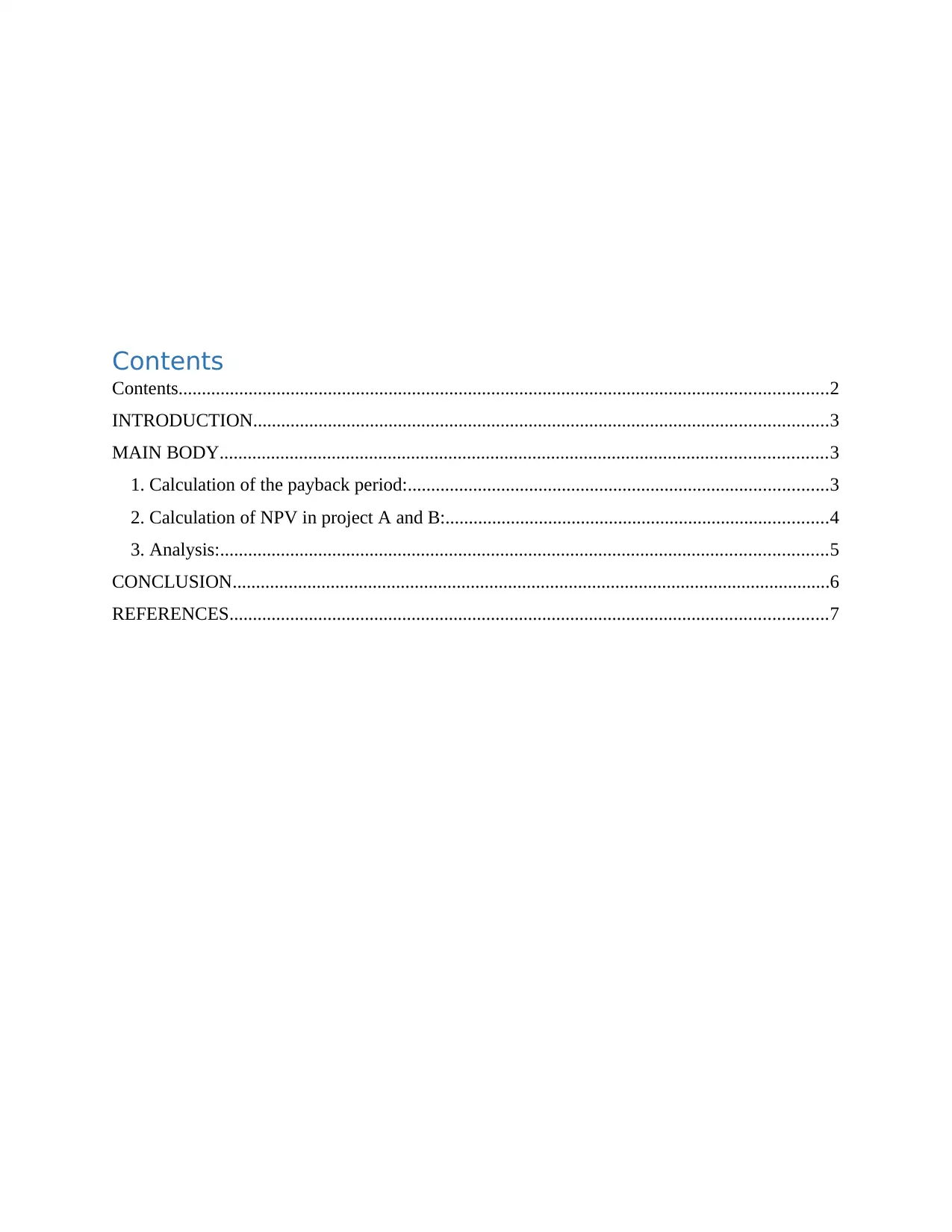
Contents
Contents...........................................................................................................................................2
INTRODUCTION...........................................................................................................................3
MAIN BODY..................................................................................................................................3
1. Calculation of the payback period:..........................................................................................3
2. Calculation of NPV in project A and B:..................................................................................4
3. Analysis:..................................................................................................................................5
CONCLUSION................................................................................................................................6
REFERENCES................................................................................................................................7
Contents...........................................................................................................................................2
INTRODUCTION...........................................................................................................................3
MAIN BODY..................................................................................................................................3
1. Calculation of the payback period:..........................................................................................3
2. Calculation of NPV in project A and B:..................................................................................4
3. Analysis:..................................................................................................................................5
CONCLUSION................................................................................................................................6
REFERENCES................................................................................................................................7
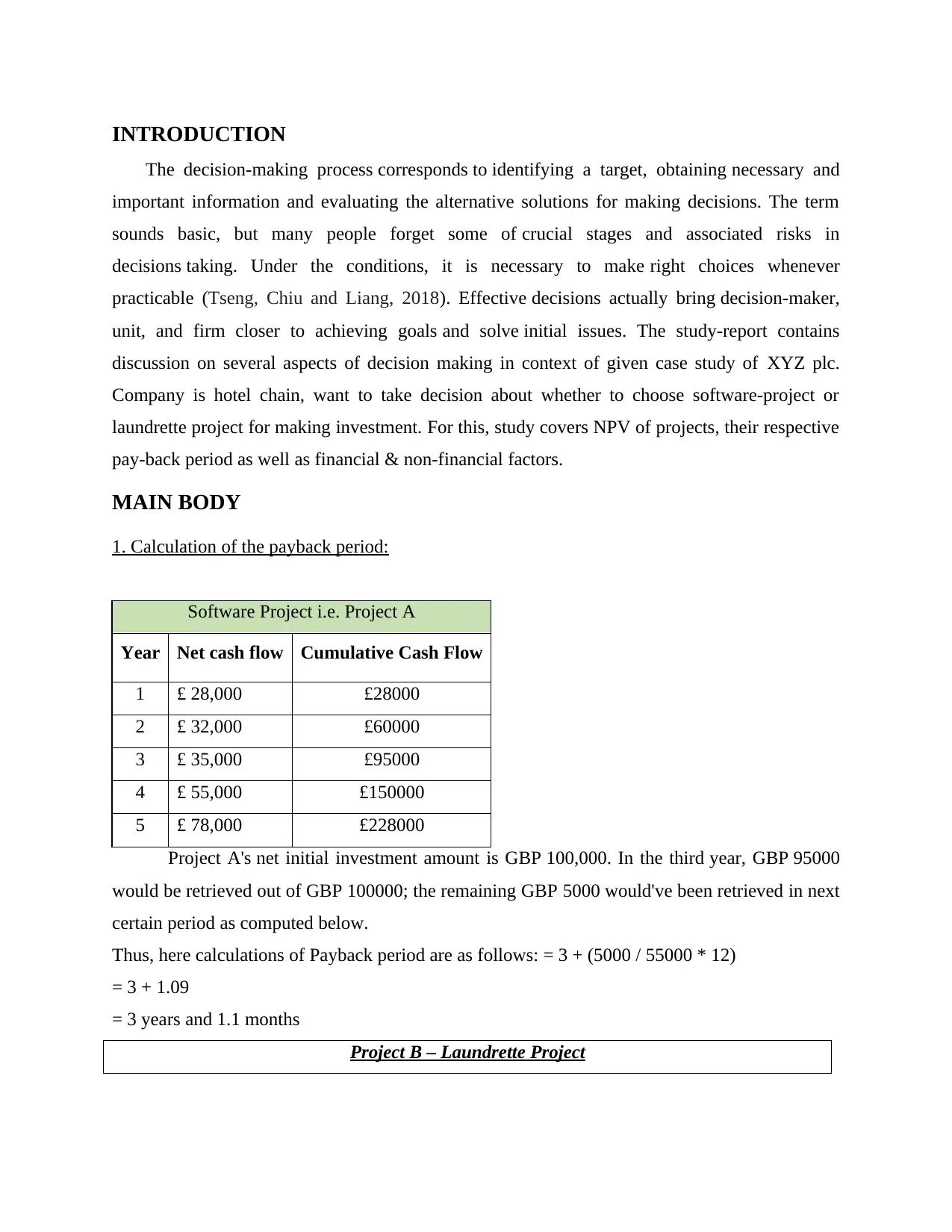
INTRODUCTION
The decision-making process corresponds to identifying a target, obtaining necessary and
important information and evaluating the alternative solutions for making decisions. The term
sounds basic, but many people forget some of crucial stages and associated risks in
decisions taking. Under the conditions, it is necessary to make right choices whenever
practicable (Tseng, Chiu and Liang, 2018). Effective decisions actually bring decision-maker,
unit, and firm closer to achieving goals and solve initial issues. The study-report contains
discussion on several aspects of decision making in context of given case study of XYZ plc.
Company is hotel chain, want to take decision about whether to choose software-project or
laundrette project for making investment. For this, study covers NPV of projects, their respective
pay-back period as well as financial & non-financial factors.
MAIN BODY
1. Calculation of the payback period:
Software Project i.e. Project A
Year Net cash flow Cumulative Cash Flow
1 £ 28,000 £28000
2 £ 32,000 £60000
3 £ 35,000 £95000
4 £ 55,000 £150000
5 £ 78,000 £228000
Project A's net initial investment amount is GBP 100,000. In the third year, GBP 95000
would be retrieved out of GBP 100000; the remaining GBP 5000 would've been retrieved in next
certain period as computed below.
Thus, here calculations of Payback period are as follows: = 3 + (5000 / 55000 * 12)
= 3 + 1.09
= 3 years and 1.1 months
Project B – Laundrette Project
The decision-making process corresponds to identifying a target, obtaining necessary and
important information and evaluating the alternative solutions for making decisions. The term
sounds basic, but many people forget some of crucial stages and associated risks in
decisions taking. Under the conditions, it is necessary to make right choices whenever
practicable (Tseng, Chiu and Liang, 2018). Effective decisions actually bring decision-maker,
unit, and firm closer to achieving goals and solve initial issues. The study-report contains
discussion on several aspects of decision making in context of given case study of XYZ plc.
Company is hotel chain, want to take decision about whether to choose software-project or
laundrette project for making investment. For this, study covers NPV of projects, their respective
pay-back period as well as financial & non-financial factors.
MAIN BODY
1. Calculation of the payback period:
Software Project i.e. Project A
Year Net cash flow Cumulative Cash Flow
1 £ 28,000 £28000
2 £ 32,000 £60000
3 £ 35,000 £95000
4 £ 55,000 £150000
5 £ 78,000 £228000
Project A's net initial investment amount is GBP 100,000. In the third year, GBP 95000
would be retrieved out of GBP 100000; the remaining GBP 5000 would've been retrieved in next
certain period as computed below.
Thus, here calculations of Payback period are as follows: = 3 + (5000 / 55000 * 12)
= 3 + 1.09
= 3 years and 1.1 months
Project B – Laundrette Project
⊘ This is a preview!⊘
Do you want full access?
Subscribe today to unlock all pages.

Trusted by 1+ million students worldwide
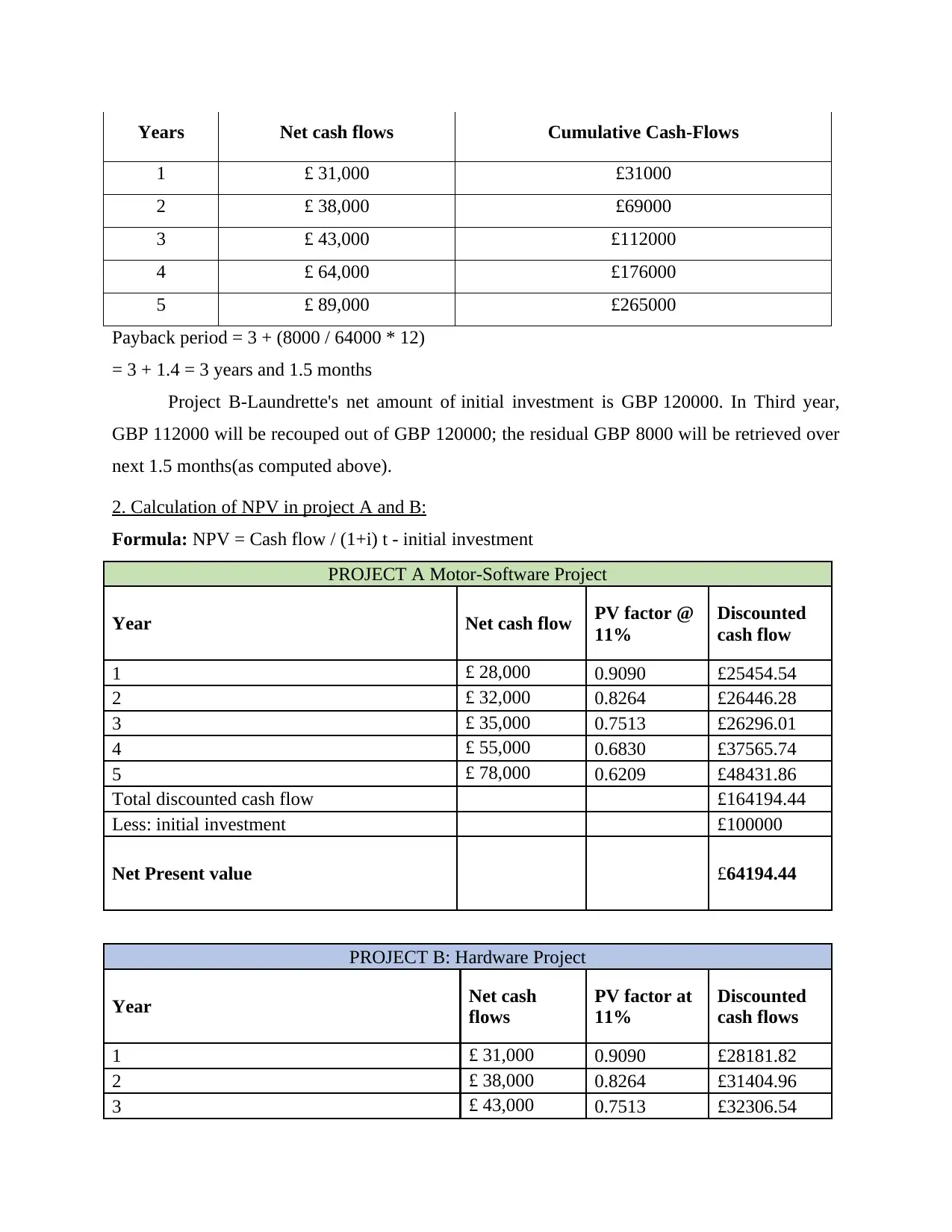
Years Net cash flows Cumulative Cash-Flows
1 £ 31,000 £31000
2 £ 38,000 £69000
3 £ 43,000 £112000
4 £ 64,000 £176000
5 £ 89,000 £265000
Payback period = 3 + (8000 / 64000 * 12)
= 3 + 1.4 = 3 years and 1.5 months
Project B-Laundrette's net amount of initial investment is GBP 120000. In Third year,
GBP 112000 will be recouped out of GBP 120000; the residual GBP 8000 will be retrieved over
next 1.5 months(as computed above).
2. Calculation of NPV in project A and B:
Formula: NPV = Cash flow / (1+i) t - initial investment
PROJECT A Motor-Software Project
Year Net cash flow PV factor @
11%
Discounted
cash flow
1 £ 28,000 0.9090 £25454.54
2 £ 32,000 0.8264 £26446.28
3 £ 35,000 0.7513 £26296.01
4 £ 55,000 0.6830 £37565.74
5 £ 78,000 0.6209 £48431.86
Total discounted cash flow £164194.44
Less: initial investment £100000
Net Present value £64194.44
PROJECT B: Hardware Project
Year Net cash
flows
PV factor at
11%
Discounted
cash flows
1 £ 31,000 0.9090 £28181.82
2 £ 38,000 0.8264 £31404.96
3 £ 43,000 0.7513 £32306.54
1 £ 31,000 £31000
2 £ 38,000 £69000
3 £ 43,000 £112000
4 £ 64,000 £176000
5 £ 89,000 £265000
Payback period = 3 + (8000 / 64000 * 12)
= 3 + 1.4 = 3 years and 1.5 months
Project B-Laundrette's net amount of initial investment is GBP 120000. In Third year,
GBP 112000 will be recouped out of GBP 120000; the residual GBP 8000 will be retrieved over
next 1.5 months(as computed above).
2. Calculation of NPV in project A and B:
Formula: NPV = Cash flow / (1+i) t - initial investment
PROJECT A Motor-Software Project
Year Net cash flow PV factor @
11%
Discounted
cash flow
1 £ 28,000 0.9090 £25454.54
2 £ 32,000 0.8264 £26446.28
3 £ 35,000 0.7513 £26296.01
4 £ 55,000 0.6830 £37565.74
5 £ 78,000 0.6209 £48431.86
Total discounted cash flow £164194.44
Less: initial investment £100000
Net Present value £64194.44
PROJECT B: Hardware Project
Year Net cash
flows
PV factor at
11%
Discounted
cash flows
1 £ 31,000 0.9090 £28181.82
2 £ 38,000 0.8264 £31404.96
3 £ 43,000 0.7513 £32306.54
Paraphrase This Document
Need a fresh take? Get an instant paraphrase of this document with our AI Paraphraser
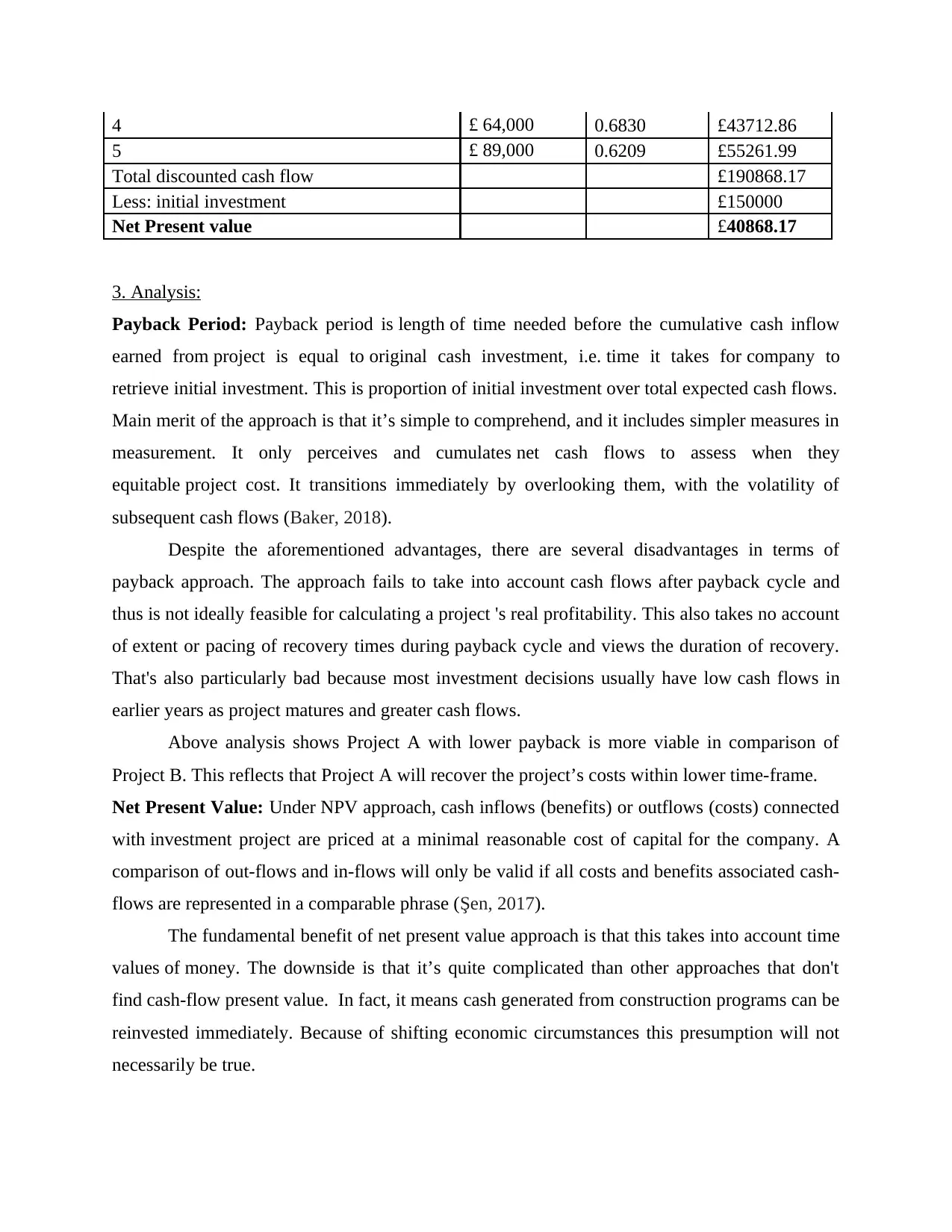
4 £ 64,000 0.6830 £43712.86
5 £ 89,000 0.6209 £55261.99
Total discounted cash flow £190868.17
Less: initial investment £150000
Net Present value £40868.17
3. Analysis:
Payback Period: Payback period is length of time needed before the cumulative cash inflow
earned from project is equal to original cash investment, i.e. time it takes for company to
retrieve initial investment. This is proportion of initial investment over total expected cash flows.
Main merit of the approach is that it’s simple to comprehend, and it includes simpler measures in
measurement. It only perceives and cumulates net cash flows to assess when they
equitable project cost. It transitions immediately by overlooking them, with the volatility of
subsequent cash flows (Baker, 2018).
Despite the aforementioned advantages, there are several disadvantages in terms of
payback approach. The approach fails to take into account cash flows after payback cycle and
thus is not ideally feasible for calculating a project 's real profitability. This also takes no account
of extent or pacing of recovery times during payback cycle and views the duration of recovery.
That's also particularly bad because most investment decisions usually have low cash flows in
earlier years as project matures and greater cash flows.
Above analysis shows Project A with lower payback is more viable in comparison of
Project B. This reflects that Project A will recover the project’s costs within lower time-frame.
Net Present Value: Under NPV approach, cash inflows (benefits) or outflows (costs) connected
with investment project are priced at a minimal reasonable cost of capital for the company. A
comparison of out-flows and in-flows will only be valid if all costs and benefits associated cash-
flows are represented in a comparable phrase (Şen, 2017).
The fundamental benefit of net present value approach is that this takes into account time
values of money. The downside is that it’s quite complicated than other approaches that don't
find cash-flow present value. In fact, it means cash generated from construction programs can be
reinvested immediately. Because of shifting economic circumstances this presumption will not
necessarily be true.
5 £ 89,000 0.6209 £55261.99
Total discounted cash flow £190868.17
Less: initial investment £150000
Net Present value £40868.17
3. Analysis:
Payback Period: Payback period is length of time needed before the cumulative cash inflow
earned from project is equal to original cash investment, i.e. time it takes for company to
retrieve initial investment. This is proportion of initial investment over total expected cash flows.
Main merit of the approach is that it’s simple to comprehend, and it includes simpler measures in
measurement. It only perceives and cumulates net cash flows to assess when they
equitable project cost. It transitions immediately by overlooking them, with the volatility of
subsequent cash flows (Baker, 2018).
Despite the aforementioned advantages, there are several disadvantages in terms of
payback approach. The approach fails to take into account cash flows after payback cycle and
thus is not ideally feasible for calculating a project 's real profitability. This also takes no account
of extent or pacing of recovery times during payback cycle and views the duration of recovery.
That's also particularly bad because most investment decisions usually have low cash flows in
earlier years as project matures and greater cash flows.
Above analysis shows Project A with lower payback is more viable in comparison of
Project B. This reflects that Project A will recover the project’s costs within lower time-frame.
Net Present Value: Under NPV approach, cash inflows (benefits) or outflows (costs) connected
with investment project are priced at a minimal reasonable cost of capital for the company. A
comparison of out-flows and in-flows will only be valid if all costs and benefits associated cash-
flows are represented in a comparable phrase (Şen, 2017).
The fundamental benefit of net present value approach is that this takes into account time
values of money. The downside is that it’s quite complicated than other approaches that don't
find cash-flow present value. In fact, it means cash generated from construction programs can be
reinvested immediately. Because of shifting economic circumstances this presumption will not
necessarily be true.
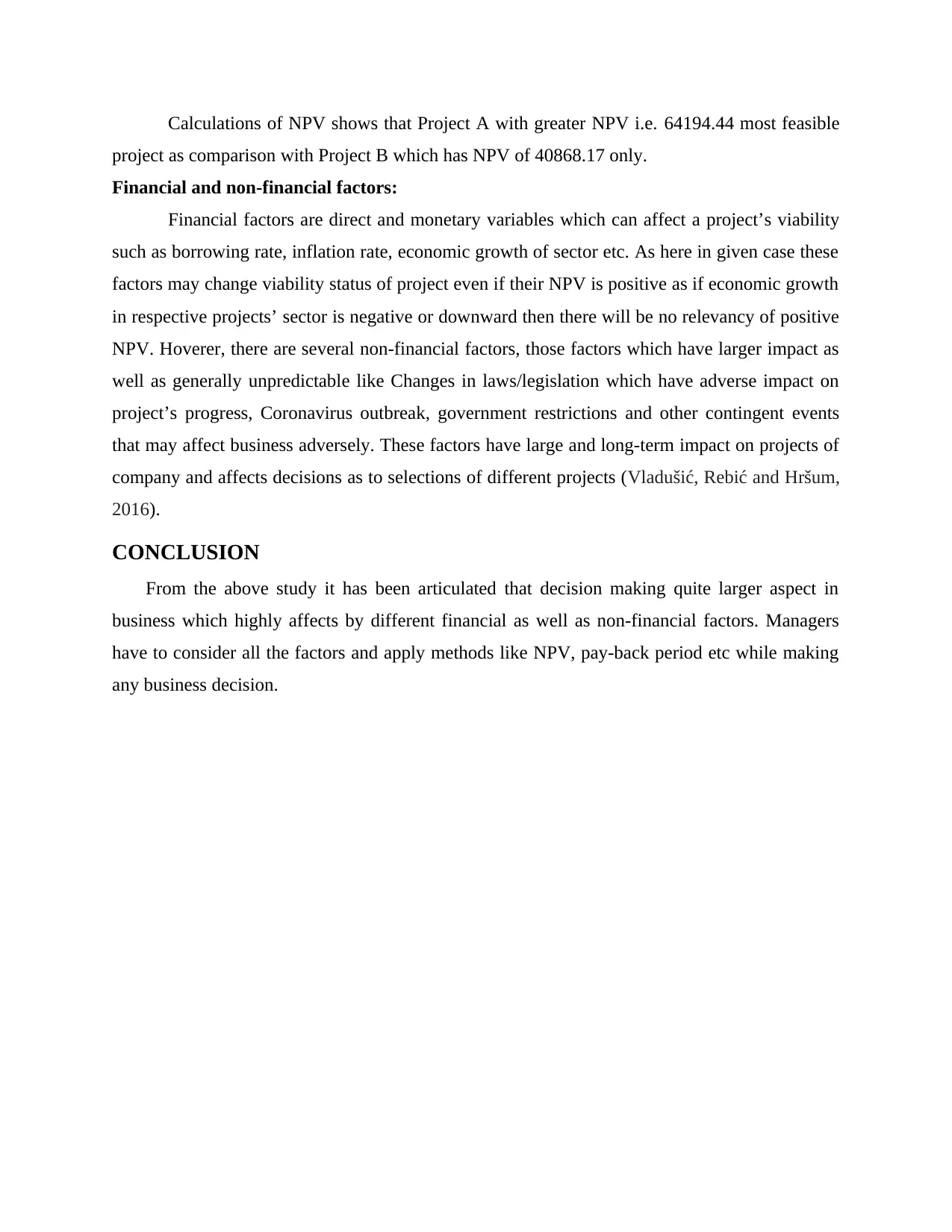
Calculations of NPV shows that Project A with greater NPV i.e. 64194.44 most feasible
project as comparison with Project B which has NPV of 40868.17 only.
Financial and non-financial factors:
Financial factors are direct and monetary variables which can affect a project’s viability
such as borrowing rate, inflation rate, economic growth of sector etc. As here in given case these
factors may change viability status of project even if their NPV is positive as if economic growth
in respective projects’ sector is negative or downward then there will be no relevancy of positive
NPV. Hoverer, there are several non-financial factors, those factors which have larger impact as
well as generally unpredictable like Changes in laws/legislation which have adverse impact on
project’s progress, Coronavirus outbreak, government restrictions and other contingent events
that may affect business adversely. These factors have large and long-term impact on projects of
company and affects decisions as to selections of different projects (Vladušić, Rebić and Hršum,
2016).
CONCLUSION
From the above study it has been articulated that decision making quite larger aspect in
business which highly affects by different financial as well as non-financial factors. Managers
have to consider all the factors and apply methods like NPV, pay-back period etc while making
any business decision.
project as comparison with Project B which has NPV of 40868.17 only.
Financial and non-financial factors:
Financial factors are direct and monetary variables which can affect a project’s viability
such as borrowing rate, inflation rate, economic growth of sector etc. As here in given case these
factors may change viability status of project even if their NPV is positive as if economic growth
in respective projects’ sector is negative or downward then there will be no relevancy of positive
NPV. Hoverer, there are several non-financial factors, those factors which have larger impact as
well as generally unpredictable like Changes in laws/legislation which have adverse impact on
project’s progress, Coronavirus outbreak, government restrictions and other contingent events
that may affect business adversely. These factors have large and long-term impact on projects of
company and affects decisions as to selections of different projects (Vladušić, Rebić and Hršum,
2016).
CONCLUSION
From the above study it has been articulated that decision making quite larger aspect in
business which highly affects by different financial as well as non-financial factors. Managers
have to consider all the factors and apply methods like NPV, pay-back period etc while making
any business decision.
⊘ This is a preview!⊘
Do you want full access?
Subscribe today to unlock all pages.

Trusted by 1+ million students worldwide
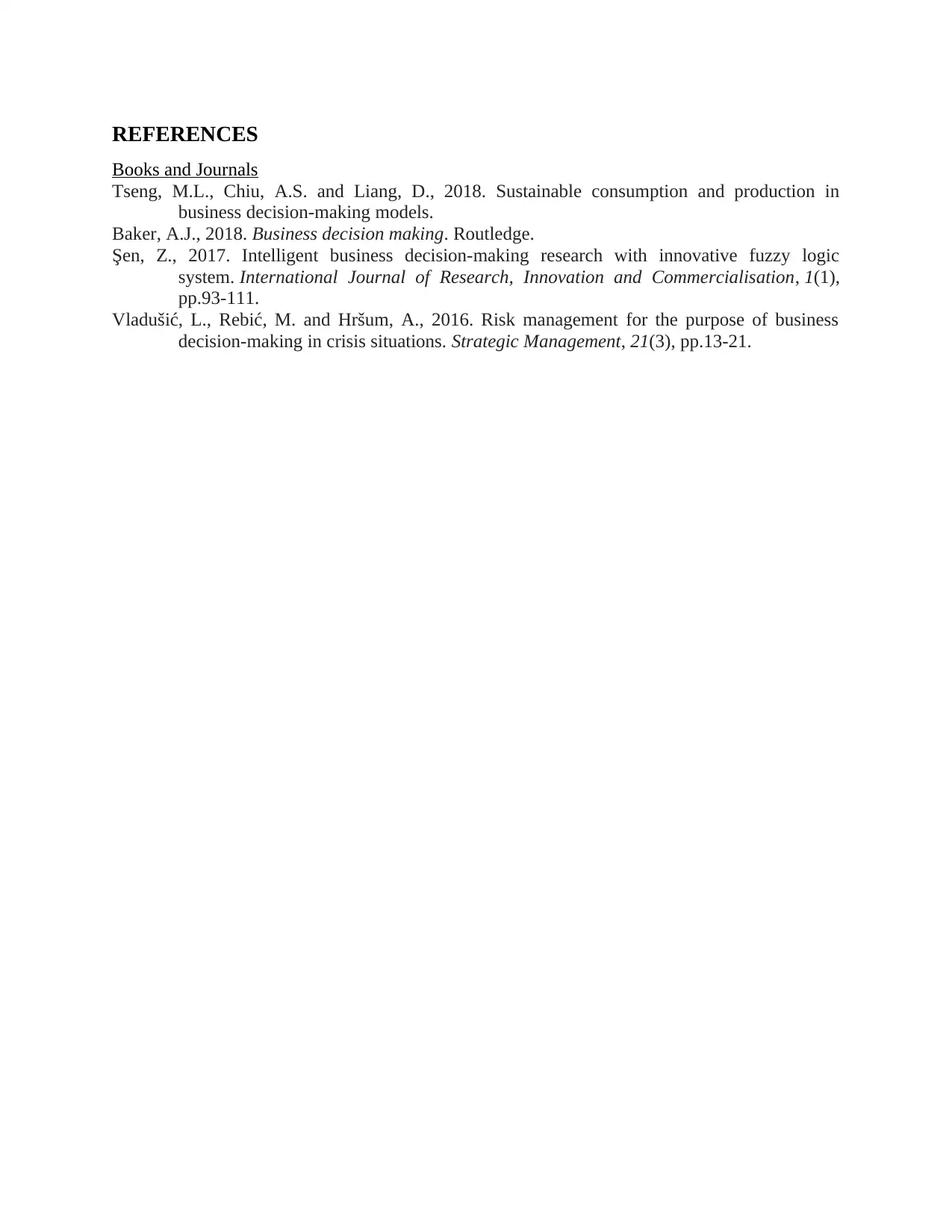
REFERENCES
Books and Journals
Tseng, M.L., Chiu, A.S. and Liang, D., 2018. Sustainable consumption and production in
business decision-making models.
Baker, A.J., 2018. Business decision making. Routledge.
Şen, Z., 2017. Intelligent business decision-making research with innovative fuzzy logic
system. International Journal of Research, Innovation and Commercialisation, 1(1),
pp.93-111.
Vladušić, L., Rebić, M. and Hršum, A., 2016. Risk management for the purpose of business
decision-making in crisis situations. Strategic Management, 21(3), pp.13-21.
Books and Journals
Tseng, M.L., Chiu, A.S. and Liang, D., 2018. Sustainable consumption and production in
business decision-making models.
Baker, A.J., 2018. Business decision making. Routledge.
Şen, Z., 2017. Intelligent business decision-making research with innovative fuzzy logic
system. International Journal of Research, Innovation and Commercialisation, 1(1),
pp.93-111.
Vladušić, L., Rebić, M. and Hršum, A., 2016. Risk management for the purpose of business
decision-making in crisis situations. Strategic Management, 21(3), pp.13-21.
1 out of 7
Related Documents
Your All-in-One AI-Powered Toolkit for Academic Success.
+13062052269
info@desklib.com
Available 24*7 on WhatsApp / Email
![[object Object]](/_next/static/media/star-bottom.7253800d.svg)
Unlock your academic potential
Copyright © 2020–2025 A2Z Services. All Rights Reserved. Developed and managed by ZUCOL.





